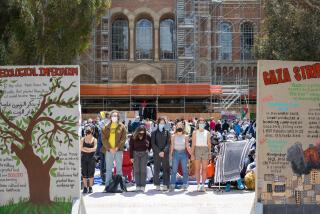For Historian, Easy Answers on Nixon Can Be Tricky
- Share via
After listening to historian Irwin Gellman of Corona del Mar defend Richard Nixon to a luncheon group, I knew interviewing him wasn’t going to be easy.
Gellman, who teaches at Chapman University, is a noted scholar on FDR. He’s a Pulitzer Prize nominee for his 1995 “Secret Affairs” about Franklin Roosevelt and Cordell Hull. But he’s also in the midst of writing a three-volume series on Nixon and let’s just say his conclusions on Nixon--so far anyway--differ from many of mine.
I never forgave Nixon for defeating Hubert Humphrey in 1968, my first chance to vote. The night Nixon resigned in 1974, my assignment for my old newspaper placed me in the cheering crowd outside the White House gates. It was hard not to get caught up in the hoopla that we were shedding ourselves of a poisonous snake.
Nixon-haters beware: Gellman isn’t from the camp that sees Nixon personifying the most evil, base instincts of American politics. The professor views Nixon as a bridge between New Deal politics and the country’s natural shift to the right. He defends Nixon, especially his handling of the Alger Hiss hearings in 1948.
“We have to stop seeing Nixon as a cartoon character,” Gellman said. “He made mistakes, but we have to evaluate them as the efforts of a real person.”
Gellman blames his wife, Gloria, for starting him on what he expects to be a 10-year study of one of the most controversial characters in U.S. political history.
“I was researching a book on American diplomacy and my wife insisted on taking me to the Nixon Library, to see at least what was in my own backyard,” Gellman explained.
Once at the Richard Nixon Library & Birthplace in Yorba Linda, Gellman became awe-struck by the volume of untouched archives. (This was three years ago, when Nixon papers were newly available for scholarly review.)
“I knew then I had to get at them,” Gellman said. “If Roosevelt was the most important political figure of the first half of the century, Nixon was the same for the second half.”
So Gellman signed up with his publisher for the ambitious three-book Nixon project. Gellman just completed the first book, “Nixon in Congress.” Book Two on the vice presidency and what Gellman calls the “wilderness years” is scheduled for publication in 2003. The final years volume is slated for 2008.
Monday, Gellman gave a sneak peek of the first volume at a Balboa Bay Club luncheon for major Chapman University donors and the university’s president, James Doti.
Gellman concedes that Nixon might have been responsible for his own downfall. But he protests the popular political notion that the seeds of the dark Nixon were sown during the Alger Hiss years.
“After Watergate, people were saying, ‘Told you so.’ But I think Nixon had undergone a massive change in personality,” Gellman said. “All he did in the Alger Hiss case was prove that Hiss was a liar.”
Hiss was the former State Department diplomat who later became head of the Carnegie Endowment for International Peace. He vehemently denied allegations by journalist Whittaker Chambers that the two of them had once been part of the same communist group. Hiss was imprisoned for perjury and his career ruined.
But many anti-Nixon pundits are less concerned about Hiss than what Nixon did to Helen Gahagan Douglas. She was the congressional colleague he ran against for the U.S. Senate in 1950. Nixon called her the “Pink Lady,” the implication being she was a communist sympathizer. That would be something akin today to calling your opponent a child molester.
But again, Gellman to Nixon’s defense. It was her political opponents in her own party’s primary who first raised those charges; she was too bloodied by then to ever beat Nixon, Gellman contends.
I asked Gellman if he worried that critics would call him a Nixon apologist. No one had ever called him an FDR apologist, he responded.
“Roosevelt and Nixon were totally different. But you can admire both men the same way you might admire both Walter Lippman and William F. Buckley.”
I wasn’t about to go one-on-one with someone who has spent thousands of hours the last three years reading Nixon documents. So we shifted the conversation to something both of us enjoyed talking about: the research.
Gellman’s work on Nixon has taken him to the National Archives in Washington, the Nixon, Truman and Eisenhower libraries, various California archives, as well as the 1,500 boxes of records on Nixon at the federal facility in Laguna Niguel (known as the Ziggeraut).
“I can’t tell you where Nixon went wrong because I haven’t got that far yet,” Gellman said. “My work is going to be based on the documents. And reading them is a slow process.”
That’s his complaint about other Nixon biographers: “They wouldn’t do the work; they wouldn’t pay the price.”
What about Stephen Ambrose? He’s considered a leading and objective Nixon biographer.
Gellman frowned: “Don’t make me say it. Ambrose said he spent six weeks in Laguna Niguel. There are a million pages of documents on Nixon there. Can you read those in six weeks? I’m only one-third the way through them, and I’ve been at it for months.”
Jerry Hicks’ column appears Tuesday, Thursday and Saturday. Readers may reach Hicks by calling the Times Orange County Edition at (714) 966-7823 or by fax to (714) 966-7711, or e-mail to jerry.hicks@latimes.com
More to Read
Sign up for Essential California
The most important California stories and recommendations in your inbox every morning.
You may occasionally receive promotional content from the Los Angeles Times.













